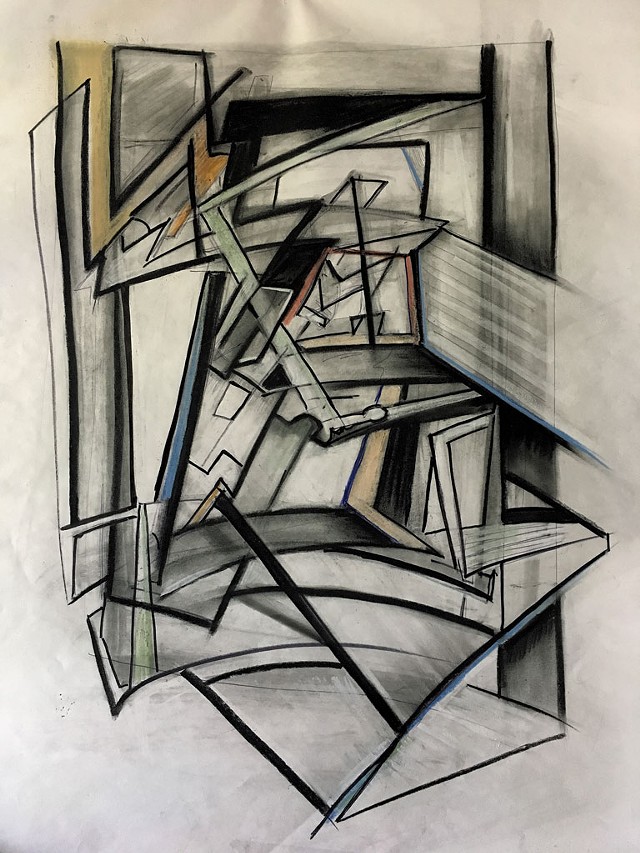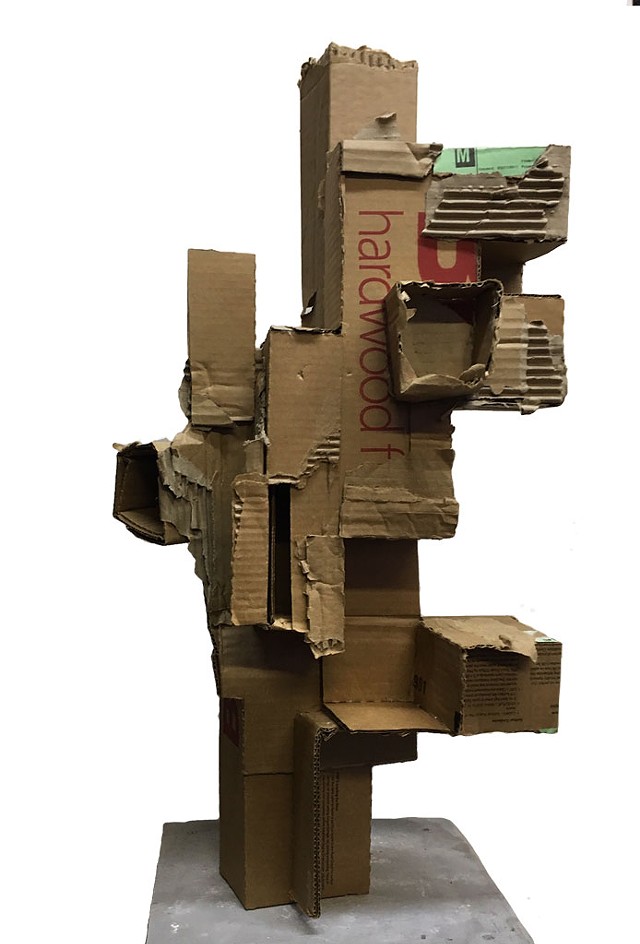
- Pamela Polst0n
- John Matusz
John Matusz's Waitsfield studio sits so close to Vermont Route 100 that passing motorists can't help but notice his outdoor sculptures. Just feet from the road, they beckon like eager emissaries of art. Occasionally people turn around and come back, he says. Maybe even buy something.
The shop, about the size of a double garage, is packed with more sculptures, along with drawings, exhibition posters, tools of the artist's trade, random doodads and artifacts that hint at Matusz's wry humor. All of this has accumulated since he bought the property 25 years ago. It looks like a fun place to explore.
Most of Matusz's sculptures are assertively large and weighty — abstract configurations of welded steel and sometimes stone or other materials that can withstand Vermont's inclemency. He's made his name with this kind of work, taking commissions for private and public installations; his sculptures can also be seen at Stowe's West Branch Gallery & Sculpture Park and in exhibitions such as the annual "Exposed" show at the Helen Day Art Center, also in Stowe. But none of this is the reason for a reporter's visit on a recent weekend.
Matusz, 72, is currently exhibiting seven sculptures at Axel's Gallery & Frame Shop in Waterbury, and the medium couldn't be more surprising if he'd made them of feathers. In fact, these "collage sculptures," as he calls them, are constructed from cardboard.
Ranging in height from 27 to nearly 70 inches, each titled "Edifice" with a number, they might pass for outré architectural models if not for the glued-on scraps of corrugated cardboard. One piece also sports a petite rectangle of sandpaper and a shard of mirror. If Matusz continued in this vein, one imagines his constructions might get increasingly fanciful, veritable magnets for random detritus.
The exhibition also includes large abstract drawings that employ charcoal, ballpoint and felt-tip pen, and pastel. These are dynamic exercises in line, volume, perspective and movement. Only one is in full color.
Sitting in his "office" — a space just large enough for a chair, sandwiched between an exceedingly cluttered desk and an unfinished painting he started in the 1970s — Matusz talked about his latest work, technology and materiality. He dusted off a stool for his visitor.

- Courtesy Of John Matusz
- Untitled
SEVEN DAYS: Why don't you have a website?
JOHN MATUSZ: [Grimaces] At the risk of embarrassing myself, I have never taken up the computer ... I asked other artists how [having a website] translated into sales, and they say not much at all.
SD: Where are you from and when did you to come to Vermont?
JM: Rome, N.Y. I came to Vermont in 1971, winter. I got laid off from work and thought I'd take time off and go skiing.
SD: What's your art background?
JM: I'm self-taught. As a kid, I drew all the time, representationally — cars, people, horses. [In the 1960s,] everyone was into abstract. I did sell some paintings, but I had more success after transitioning to sculpture. And storage is easy: You just put 'em outdoors.
In 1984, I was a founder of Notch Fine Art Co-op [in Waitsfield]. In those years I was working at a ski resort. I was in Switzerland at a ski-racing camp and got a call from the gallery: They had sold $3,000 worth of my sculpture. That's when I thought I could make this work.
SD: What were those sculptures?
JM: Abstract welded steel. Two of them I'd painted red. I phased out of painting and into sculpture.
I was a New York State-certified welder — I learned a lot of structural principles. I have an intuitive sense of what you can do with steel. I wanted to make a statement by making them larger. It's kind of showing off, showing what you can do. The bigger you make them, the more challenges you have.
SD: So, cardboard. Were you taking a break [from metal] to play, or do your paper sculptures represent a new direction?
JM: I wouldn't say "play." Maybe experimenting. I had some health issues last year and had to take a break from heavy work. At around that time, I went to a collage show at Studio Place Arts [in Barre] that I enjoyed. But it was all two-dimensional, on the wall. I didn't see any on the floor. I thought I'd make paper sculptural collage.
I made one, just crudely, tearing cardboard and gluing [the pieces] with a hot-glue gun. When I got done, I thought that this is crude — but I liked it.
At first, I would use each [torn] piece immediately. My next phase was ripping a bunch of cardboard so I had a pile of pieces to choose from. Next, rather than ripping, I started cutting cardboard with an X-Acto knife.
People ask me if [the sculptures] are maquettes. They're not. They are what they are.

- Courtesy Of John Matusz
- "Edifice #4"
SD: Do you plan to make more?
JM: I'll make at least one more. My intention is to use that stuff [points to sheets of honeycomb cardboard leaning against a wall]. I get my cardboard from Bisbee's [Ace Hardware, in Waitsfield]. Those were dividers in a pallet of paint cans.
SD: Did the relative weightlessness of cardboard liberate your technique?
JM: Not really. But I did build up the base with blocks of wood and a steel plate [so the pieces wouldn't fall or blow over]. The difference wasn't the approach but in the process — tearing a quasi-sturdy material with my bare hands.
My father was a carpenter. As kids, my brother and I were grunts on his work sites. I learned a lot of basic skills ... My dad could draw really well; that fascinated me, too. I think that influenced my drawing.
SD: Tell me about your abstract drawings [at Axel's]. What do you start with? Obviously not from life but an idea in your head.
JM: I just [want to] start a new drawing — that's what those are all about. I put some lines down, and, when I feel that one of them is the "right" line, I start with that.
My usual medium is charcoal. The two drawings on either end [of the gallery wall] are the newest, from 2018. They're different because I began drawing with a ballpoint pen, then a felt-tip pen. When I decided to make [the composition] pop more, I'd go into shading.
This process is my latest drawing technique. You can see some [pen] lines, some mistakes, but that's all right.
SD: The artist's hand is visible.
JM: Yeah. Some people like that.
SD: How do you figure out what prices to put on stuff?
JM: Basically, experience over the decades. With the cardboard works, the prices are low. People don't value the material ... people see a cardboard sculpture as opposed to bronze.
SD: The durability. And yet all works on paper are fragile and have to be protected.
JM: Yeah. A lot of work is fragile — glass, clay ... But I didn't have the nerve to put $2,000 on them or whatever. I believe the drawings have more salability.
This interview has been edited and condensed for length and clarity.










Comments
Comments are closed.
From 2014-2020, Seven Days allowed readers to comment on all stories posted on our website. While we've appreciated the suggestions and insights, right now Seven Days is prioritizing our core mission — producing high-quality, responsible local journalism — over moderating online debates between readers.
To criticize, correct or praise our reporting, please send us a letter to the editor or send us a tip. We’ll check it out and report the results.
Online comments may return when we have better tech tools for managing them. Thanks for reading.